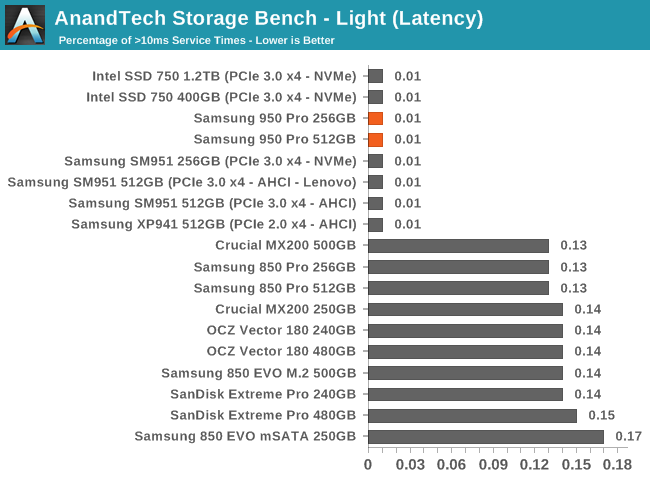The Samsung 950 Pro PCIe SSD Review (256GB and 512GB)
by Billy Tallis on October 22, 2015 10:55 AM ESTAnandTech Storage Bench - Light
Out Light storage test has relatively more sequential accesses and lower queue depths than The Destroyer or the Heavy test, and it's by far the shortest test overall. It's based largely on applications that aren't highly dependent on storage performance, so application launch times and file load times are what dominate this test. Details of the Light test can be found here.

The Light test starts to show a distinct advantage for NVMe, and the Samsung UBX controller is performing much better than Intel's SSD 750.

The three Samsung NVMe drives have the lowest average service time and the SATA drives are all looking quite slow by comparison.

The PCIe drives are all very good about keeping latency outliers to a minimum, but none have yet managed to complete the entire test without any request taking more than 10ms.

Despite stellar performance, the 950 Pro's power efficiency is poor. If our system could make use of some power management capabilities this situation could be very different, but for many consumers this is just the way things are for PCIe drives. The lack of power management support may be slightly helping some of the latency scores, as transitioning between power states usually requires a short interruption in service.










142 Comments
View All Comments
AnnonymousCoward - Thursday, October 22, 2015 - link
This 5,600-word review utterly fails to penetrate to the bottom-line answer: the 950 Pro gives virtually zero desktop-usage performance advantage, while costing more than double of SATAIII drives. That only took 17 words.http://techreport.com/review/29221/samsung-950-pro...
Redstorm - Thursday, October 22, 2015 - link
Quote: "Lucky for that Samsung 950 Pro SSD or i would never have made that head shot" - said no one ever.PVG - Thursday, October 22, 2015 - link
I don't want to believe you tested a PCIe 3.0 4x drive on a board with a PCIe 2.0 x2 M.2 socket, so I'm guessing you used some kind of PCIe card adapter hooked up to the 3.0 lanes from de CPU, right?Billy Tallis - Friday, October 23, 2015 - link
Yep. We're always using the PCIe lanes off the CPU, and with a riser card and adapter that allows for the power measurement.PVG - Saturday, October 24, 2015 - link
That sounds like a cool setup. You should show it, sometime. ;)zodiacfml - Friday, October 23, 2015 - link
I'm just impressed with the SM951. All these PCIe drives are not terrible and gives excellent performance over SATA anyway. Their differences are pretty negligible in real world use. The challenge now (esp. for Samsung) is more capacity and lower prices.I can't shake the idea of NAS devices with M.2 drives.
zodiacfml - Friday, October 23, 2015 - link
Additionally, NVMe doesn't improve much for the clients. It seems like a specification they added on consumer drives to increase its adoption to benefit their server/enterprise storage products.wyewye - Friday, October 23, 2015 - link
Billy, you shit the bed: half of graphs are randomly missing Intel 750, the only competing consumer drive.However, good job on highlighting the termal issues of 950 Pro.
lilmoe - Saturday, October 24, 2015 - link
Welcome to the world of amazingly consistent charts, brought to you by Anandtech.SyukriLajin - Friday, October 23, 2015 - link
who knew that storage would require bandwidth as high as a graphic card. just a few years ago, it's the slowest component of your computer.